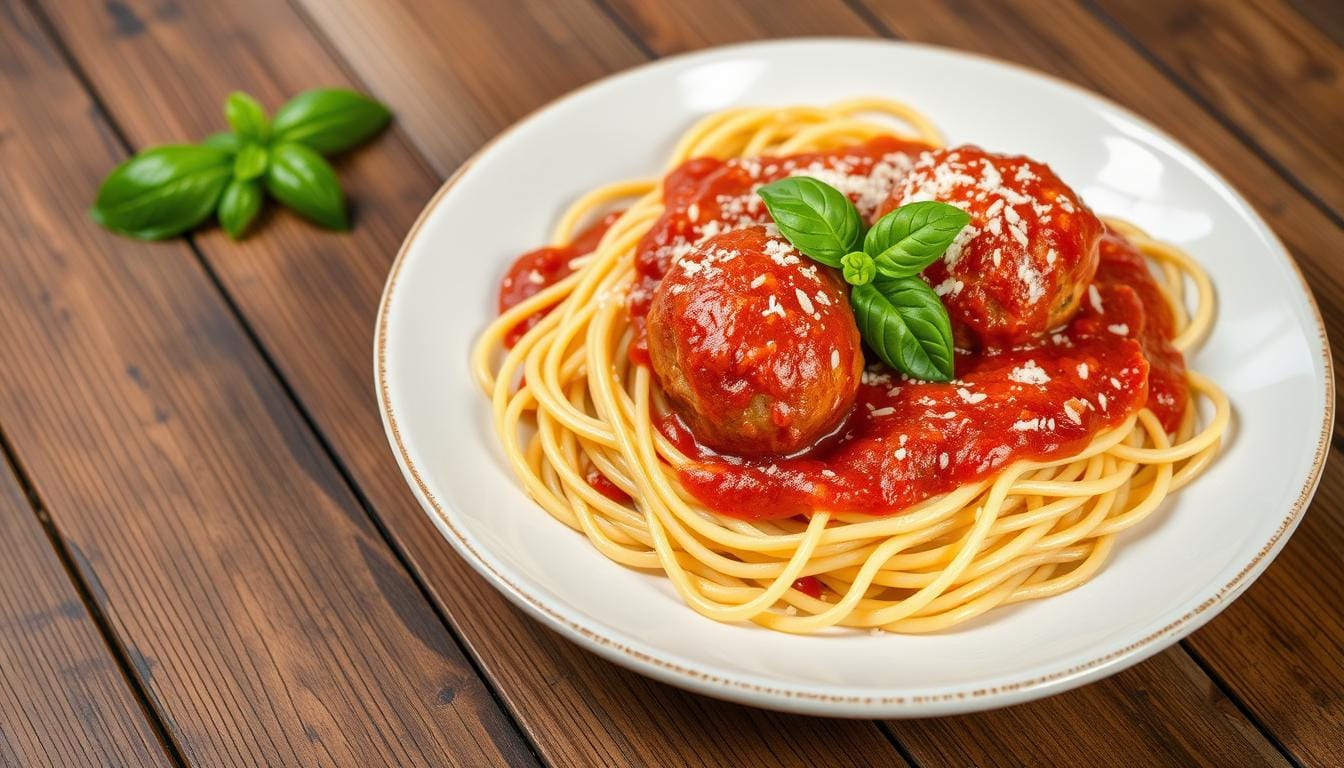The smell of marinara sauce and meatballs takes you to an Italian kitchen. Pasta with marinara sauce was more than food to me. It was about family, tradition, and love. Every bite was a story of comfort and connection.
This classic dish is more than just pasta and sauce. It’s a journey through Italian-American flavors. Spaghetti and meatballs sauce is a nostalgic experience that links generations through food.
Making meatballs for pasta is an art that needs patience and skill. From choosing the right ground beef to making the best marinara sauce, every step is special. It’s a chance to create something truly unique.
Key Takeaways
- Classic Italian-American comfort food that brings families together
- Perfect balance of tender meatballs and rich marinara sauce
- Versatile dish that can be customized to personal taste
- Preparation takes approximately 40 minutes total
- Nutritious meal with balanced protein and carbohydrates
- Can be easily stored and reheated for convenient meals
Introduction to Classic Italian-American Pasta and Meatballs
Spaghetti and meatballs take us on a tasty journey between two cultures. Italian immigrants came to the United States in the late 1800s. They brought their delicious cooking traditions with them, changing American food forever.
The tale of spaghetti and meatballs is tied to the immigrant story. Millions of Italians, mostly from the south, moved to America. They made their old recipes fit the new land’s plenty.
Origins of the Beloved Comfort Food
In Italy, pasta and meatballs were eaten differently. Polpette (meatballs) were a main dish, and pasta was a starter. In America, these dishes merged into the famous spaghetti and meatballs we love today.
- Italian immigrants introduced meatballs to America in the 1800s
- Traditional Italian meatballs were walnut-sized
- American versions grew larger, becoming baseball-sized
Why This Dish Remains a Family Favorite
Your family’s love for spaghetti and meatballs is more than just taste. It’s about tradition. A classic meatball recipe mixes tender meat, herbs, and rich sauce, making a meal that warms the heart.
“Food is our common ground, a universal experience.” – James Beard
Spaghetti and meatballs are loved for their simplicity. With two meatballs per plate, it’s a favorite in Italian-American homes. It brings families together through shared meals.
Essential Ingredients for Perfect Meatballs and Marinara
To make authentic meatballs in tomato sauce, you need the right ingredients. These ingredients bring the true taste of Italian-American cuisine to your table. Start your journey to making delicious homemade meatballs by knowing the key ingredients.
For the best meatballs, choose high-quality ingredients that mix well. Here’s what you need:
Meat Selection
- Ground beef chuck (80% lean): 1 pound
- Ground pork or veal: 1 pound
- Pro tip: Mixing meats creates a more complex flavor profile
Binding Ingredients
| Ingredient | Quantity | Purpose |
|---|---|---|
| Fresh breadcrumbs | ½ cup | Helps maintain moisture |
| Milk | ¼ cup | Adds tenderness |
| Egg yolks | 2 | Binds ingredients |
The secret to amazing meatballs in tomato sauce is the right mix of ingredients. Grated cheese, like Pecorino Romano or Parmesan, adds flavor. Fresh herbs and garlic give it that Italian-American taste.
“Great meatballs are about quality ingredients and love in preparation” – Italian Cooking Wisdom
Seasoning Essentials
- Grated cheese: ½ cup
- Garlic: 2 finely chopped cloves
- Salt: 1 teaspoon
- Fresh herbs: ⅓ cup
- Italian seasoning: 2 teaspoons
Choose fresh, high-quality ingredients and mix them with care. The right mix turns simple ingredients into a memorable Italian-American dish.
Step-by-Step Guide to Making Homemade Meatballs
Making the perfect meatballs takes skill, passion, and detail. They can turn a simple meal into a special experience. Let’s explore how to make delicious meatballs that will wow your loved ones.
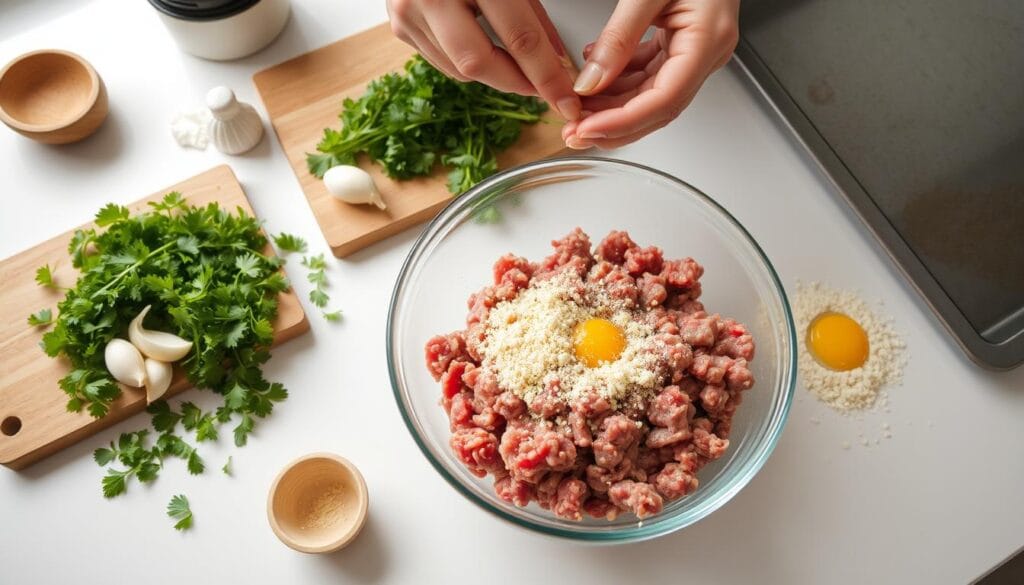
Mastering the Meatball Mixture
Start by picking the right ingredients for your meatballs. Use ground beef with 85% lean meat for the best taste. Here’s what you need:
- 1 pound ground beef
- 1/2 cup breadcrumbs
- 1 large egg
- 1/4 cup grated Parmesan cheese
- 2 minced garlic cloves
- 1 teaspoon kosher salt
- 1/4 cup chopped parsley
Cooking Techniques for Perfect Texture
The key to tender meatballs is gentle handling and precise cooking. Don’t overmix the meat to avoid toughness. Here are some ways to cook them:
| Cooking Method | Temperature | Cooking Time |
|---|---|---|
| Broiling | Preheated broiler | 10-12 minutes (one side), 2-3 minutes after flipping |
| Air Frying | 375°F | 12-15 minutes |
| Slow Cooker | Low heat | 6 hours or High heat for 3 hours |
Tips for Achieving the Ideal Meatball
Here are some tips to make your meatballs stand out:
- Use room temperature ingredients for better mixing
- Form meatballs about ⅓ cup in size
- Use olive oil for frying to enhance flavor
- Let meatballs rest in sauce for at least 1½ hours
“The perfect meatball is a delicate balance of flavor, texture, and love.” – Culinary Wisdom
With these tips, you’ll make meatballs that everyone will love. Don’t be afraid to try new things and have fun cooking!
Crafting the Perfect Marinara Sauce
Making your own pasta sauce can turn a simple dish into a masterpiece. A great marinara sauce recipe needs focus and the right ingredients. Your sauce will be the key to making the meal unforgettable.
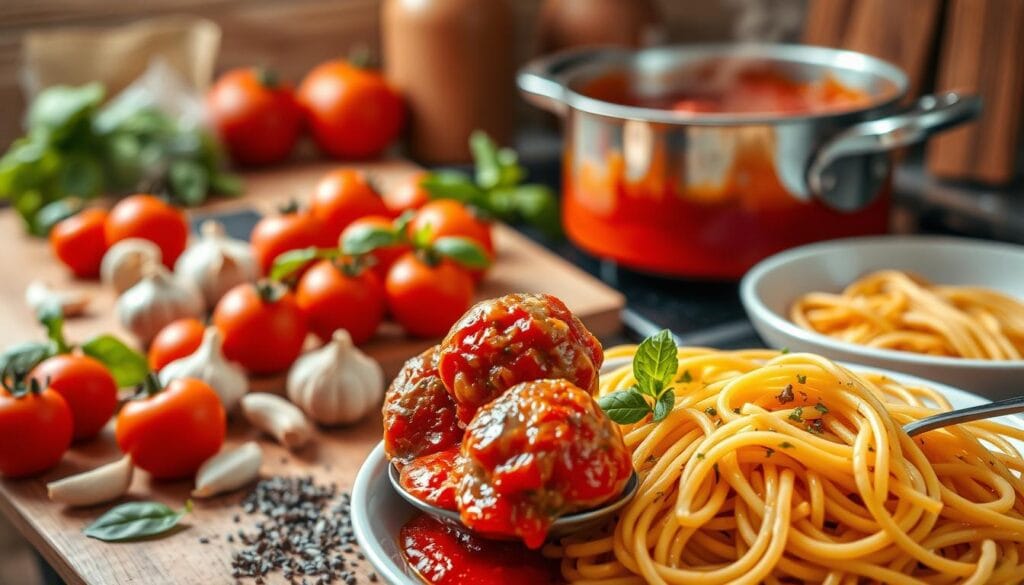
Choose top-notch ingredients for the best flavor. Here are the must-haves for a fantastic homemade pasta sauce:
- Crushed tomatoes (28 oz can)
- Fresh garlic cloves (3 total)
- Extra virgin olive oil (2 tablespoons)
- Tomato paste (6 oz can)
- Chopped fresh basil (1/4 cup)
- Dried oregano (1 teaspoon)
- Grated Parmesan cheese (3 tablespoons)
How you cook your sauce matters a lot. Slow simmering brings out the best flavors. Simmer your sauce for about 30 minutes to enhance the tomato’s sweetness and herb taste.
“The secret to a great marinara is patience and quality ingredients” – Italian Cooking Tradition
For the best sauce, add 1/4 cup of heavy cream for creaminess. Also, adjust the salt to your liking. Even pros like using Rao’s marinara, but making your own lets you tailor the taste.
Your homemade marinara sauce is a chance to make a meal that will impress everyone. With the right ingredients and care, you’ll turn simple pasta into a special occasion dish.
Pasta with Marinara Sauce with Two Meatballs in It: Traditional Preparation
Making the perfect pasta with meatballs needs care and precision. It’s about finding the right balance of cooking and presentation. This turns a simple meal into a work of art.
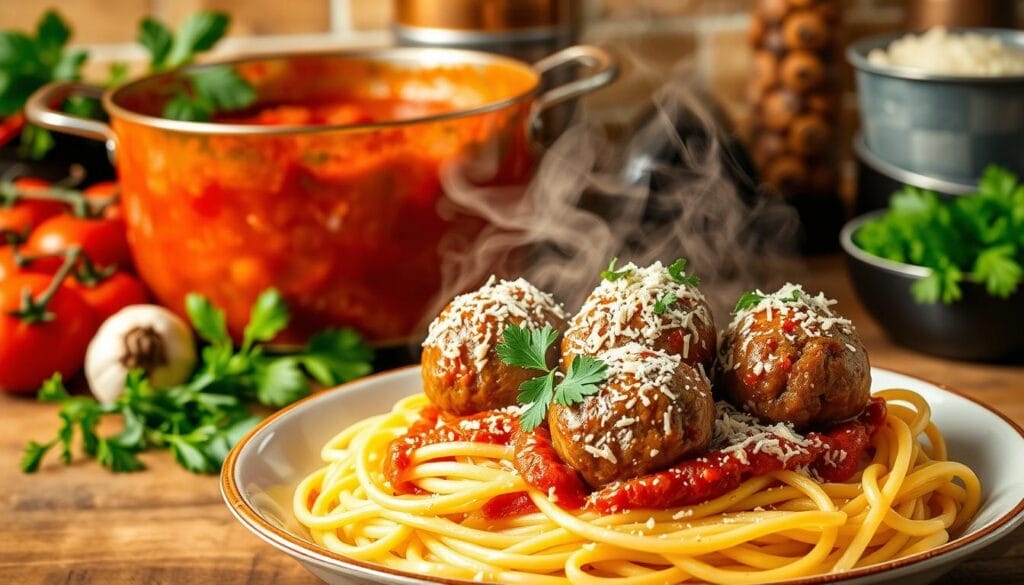
For this classic dish, several steps are key. They make sure your pasta dish looks great and tastes even better.
Cooking Time and Temperature Guidelines
- Pasta cooking time: About 10 minutes for the perfect texture
- Meatball internal temperature: 155°F
- Sauce simmering time: 15-20 minutes on low heat
- Water for boiling pasta: 4 quarts
Assembly and Presentation Tips
Getting the presentation right is all about the details. Start by picking the right plate. Then, arrange your ingredients carefully.
- Cook pasta until it’s just right
- Drain pasta well
- Put pasta in a warm dish
- Top with marinara sauce
- Place two meatballs on top
- Add fresh parsley for a pop of color
Pro tip: Warm your plates before serving. It keeps the dish hot and inviting.
“The secret to a great pasta dish is in the details of preparation and presentation.” – Italian Culinary Expert
| Preparation Stage | Time Required | Key Considerations |
|---|---|---|
| Pasta Cooking | 10 minutes | Maintain al dente texture |
| Meatball Cooking | 15-20 minutes | Reach 155°F internal temperature |
| Sauce Simmering | 15-20 minutes | Low heat for rich flavor development |
By following these steps, you’ll make a pasta dish that’s restaurant-quality. It will impress your family and friends.
Best Pasta Types for Meatball Dishes
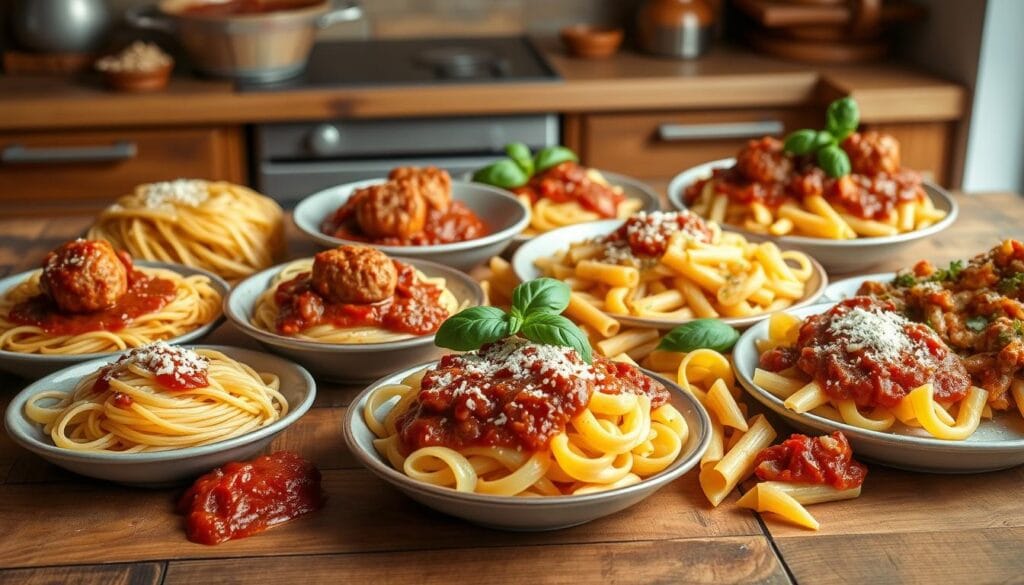
Choosing the right pasta for meatballs can make your meal better. While spaghetti is a classic, trying other options can make it even better. The goal is to find pasta that goes well with your meatballs.
Different pasta shapes work in unique ways with sauce and meatballs. Think about pasta that catches sauce and offers a nice texture contrast.
Top Pasta Choices for Meatball Dishes
- Rotini: Spiral shape catches sauce beautifully
- Penne: Tubular design holds meat sauce perfectly
- Rigatoni: Large tubes create dramatic presentation
- Fusilli: Twisted shape adds visual interest
When picking pasta for meatballs, think about cooking time and how well it holds sauce. Short pasta like elbows or ditalini is great for easy-to-eat meals.
Pro tip: Match your pasta’s cooking time to ensure perfect texture alongside your meatballs!
Pasta and Meatball Pairing Guide
| Pasta Type | Sauce Compatibility | Cooking Time |
|---|---|---|
| Rotini | Excellent | 8-10 minutes |
| Penne | Very Good | 10-12 minutes |
| Rigatoni | Outstanding | 12-14 minutes |
The right pasta can make a good meatball dish great. Try different shapes to find your family’s favorite!
Storage and Reheating Instructions
Keeping your pasta and meatballs tasty means storing and reheating them right. Learning how to store and reheat helps you enjoy your meal later. It keeps the flavors and texture just right.
Refrigerator Storage Guidelines
Here are key tips for storing your meatball pasta:
- Store leftovers in an airtight container
- Refrigerate within 2 hours of cooking
- Keep in the fridge for 2-3 days maximum
Freezing Methods for Long-Term Preservation
Freezing your meatball pasta makes reheating a breeze. Follow these steps to freeze it well:
- Separate meatballs and sauce from pasta
- Use freezer-safe containers
- Freeze meatballs and sauce for up to 3 months
- Label containers with the date of freezing
Best Practices for Reheating
Reheat your pasta and meatballs with these methods:
- Microwave method: Heat individual portions for 1-2 minutes on high
- Stovetop technique: Warm gently in a pan
- Add a splash of water or extra sauce to prevent drying
Pro tip: Thaw frozen meatballs and sauce in the refrigerator overnight before reheating for the best results.
Recipe Variations and Customization Options
Exploring different meatball recipes and pasta customizations can turn a simple meal into a fun adventure. Your basic recipe is a great base for many creative changes. These changes can meet various dietary needs and taste preferences.
Here are some tasty ways to make your pasta and meatballs your own:
- Ground Meat Alternatives:
- Turkey meatballs (93% lean recommended)
- Chicken meatballs for lighter protein
- Plant-based meat substitutes for vegetarian options
- Gluten-Free Modifications:
- Almond flour instead of breadcrumbs
- Gluten-free pasta varieties
- Certified gluten-free marinara sauce
Try new seasonings to spice up your meatballs. Here are some ideas:
- Spice Blend Options:
- 2 teaspoons Italian seasoning
- 1/2 teaspoon garlic powder
- 1/4 teaspoon onion powder
- Pinch of red pepper flakes for heat
To customize your pasta dish, add something special to your marinara sauce. Here are some ideas:
| Ingredient | Flavor Impact |
|---|---|
| Red Wine | Adds depth and complexity |
| Roasted Vegetables | Increases nutritional value |
| Fresh Herbs | Brightens overall taste profile |
Pro tip: Always adjust seasonings to your personal taste, and don’t be afraid to get creative with your meatball recipe variations!
“Cooking is an art, and every dish tells a story. Make yours unique!” – Culinary Wisdom
Nutritional Information and Health Benefits
Learning about pasta and meatballs nutrition helps you make better food choices. A typical serving of this dish offers a good mix of nutrients. These nutrients support your health and well-being.
Here’s what a standard serving of this healthy pasta dish provides:
- Calories: About 221 per cup
- Protein: 8.1g (16% of daily needs)
- Carbohydrates: 43.2g
- Fiber: 2.5g
- Iron: 1.01mg (10% of daily needs)
This dish has many nutritional benefits. Whole grain pasta adds more fiber and nutrients. Meatballs give high-quality protein for muscle health.
“Eating a balanced meal like pasta with meatballs can be part of a nutritious diet when consumed in moderation.”
Here are some key nutritional highlights:
- Low sodium content
- Moderate glycemic index (45)
- Rich in B-vitamins
- Supports energy metabolism
To make your pasta dish even healthier, try using lean meats and adding veggies. Choosing the right ingredients can turn this classic dish into a nutritious meal.
Pairing Suggestions and Side Dishes
Enhancing your pasta and meatballs experience is more than just the main dish. The right wine and side dishes can turn a simple meal into a memorable feast.
Wine and Beverage Recommendations
Finding the perfect wine can make your meatball pasta meal even better. Here are some top wine choices for your pasta and meatballs:
- Chianti: A classic medium-bodied red wine that complements tomato-based sauces
- Sangiovese: Offers rich flavors that match the robust taste of meatballs
- Pinot Noir: A lighter red wine that pairs beautifully with beef meatballs
Complementary Side Dishes
Make your meal even better with these delightful side dishes. They perfectly match pasta and meatballs:
| Side Dish Category | Recommended Options |
|---|---|
| Breads | Garlic bread, focaccia, breadsticks |
| Salads | Caesar salad, green salad with red wine vinegar dressing |
| Vegetables | Roasted broccoli, zucchini, yellow squash |
For those who prefer not to drink wine, try sparkling water with lemon or a cool iced tea. These drinks will make your pasta and meatballs a special occasion.
Pro tip: Balance your plate with a mix of textures and flavors to create a truly satisfying meal.
Conclusion
Pasta with marinara sauce and meatballs is more than a meal. It’s a dish that brings families together, connecting them through food. Your kitchen becomes a tribute to Italian immigrants who brought this dish to the United States in the 1800s.
This recipe tells a story of adaptation and creativity. It only takes 30 minutes to prepare, serving up about 550 calories per serving. You can also make it your own by adding your favorite ingredients, making it great for family dinners or casual get-togethers.
Whether you’re an experienced cook or just starting out, this recipe is easy to follow. Leftovers can be stored in the fridge for two days or frozen for a month. By making this dish, you’re not just cooking a meal. You’re keeping a tradition alive that brings people together.

